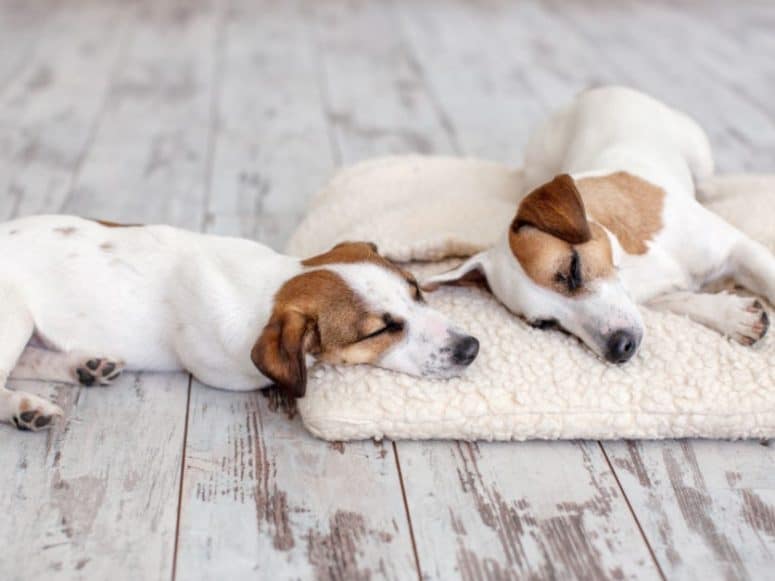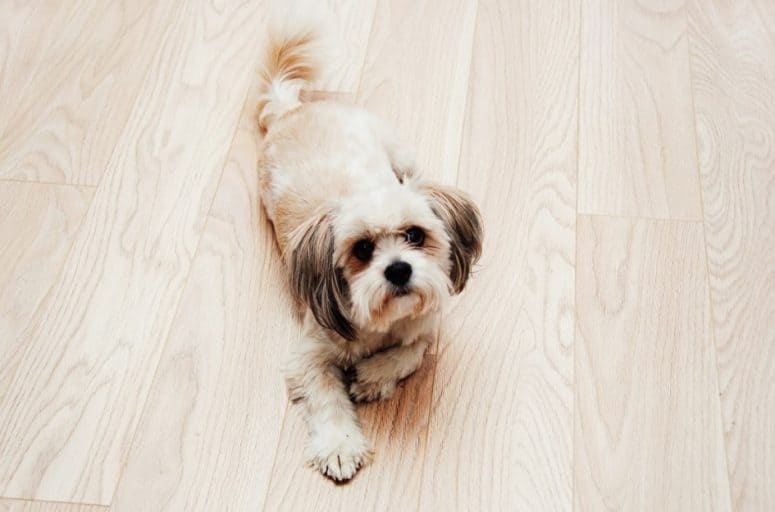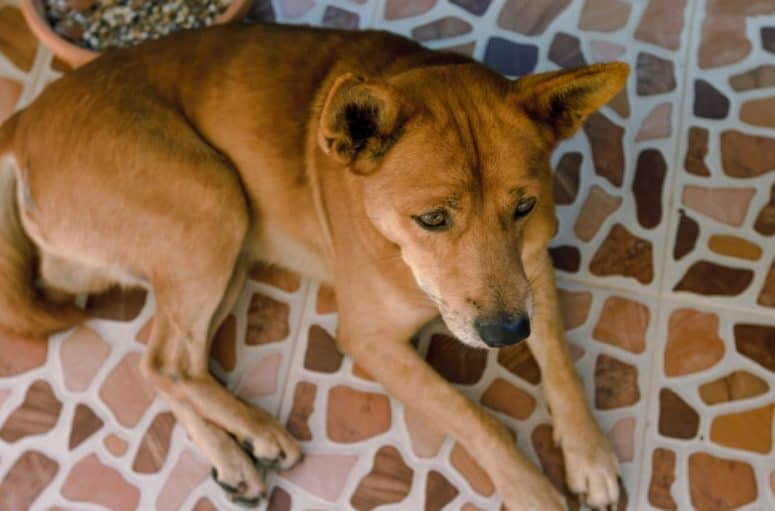Similar to humans, dogs spend a significant amount of time walking and resting on the ground. While we often find comfort on sofas, beds, or other cozy spots at home, dogs predominantly occupy the floor throughout the day. They sleep, lie down, play around, eat, and occasionally relieve themselves on the floor.
Considering this, it becomes crucial to consider your flooring choices if you have a dog or are planning to welcome one into your home. Additionally, if you intend to renovate your house’s flooring, it is essential to give careful thought to the materials and options available to accommodate your furry friend’s needs.
Things to Consider Before Choosing Flooring for Dogs
When it comes to having a dog and choosing the right flooring, there are two options: either adjust your dog to the flooring or adjust the flooring to suit your dog.
If you decide to adapt your dog to the flooring you plan to install, there are a few considerations. Trimming your dog’s nails is essential to prevent scratches on the floor. It’s also important to maintain your pet’s fur to minimize shedding throughout the house. Proper training to use a designated spot for peeing and pooping is crucial for maintaining cleanliness.
On the other hand, if you opt to adjust your flooring for your dogs, you need to select a durable type that can withstand common issues caused by dogs, such as scratches, spills, and dirt. Conduct thorough research on the pros and cons of different flooring options and how they align with your dog’s behavior, as this will make things easier for you in the long run.
Now, let’s explore the key factors to consider when adapting your flooring to accommodate dogs:
- Water resistance: Having a pet necessitates having at least water-resistant flooring in your home. Dogs, in particular, can cause various water-related issues, including spills, muddy paws, and food accidents. It’s difficult to control what your dog might do, so having a flooring type that can withstand such incidents is important.
- Scratch resistance: Dogs have paws and a natural inclination to scratch, especially after waking up or when on a soft surface. If your flooring is not scratch-resistant, it may become damaged over time due to your dog’s activities.
- Durability: While we may prioritize comfort in flooring, dogs require surfaces with good traction. Regardless of the type you choose, it should be long-lasting and durable. Replacing flooring multiple times due to pet-related wear and tear can be a challenging and unpleasant task.
Considering these factors will help you find the right flooring solution that can coexist harmoniously with your furry friend, ensuring a comfortable and practical living environment for both you and your dog.
Best Flooring Options for Dogs
Below, I present a compilation of the finest flooring choices suitable for households with dogs.
1. Vinyl

2. Solid Hardwood

Similar to humans, dogs appreciate the warmth that solid hardwood flooring offers. The natural and solid composition of hardwood creates a surface that is both firm and warm to the touch.
Interestingly, the hard surface of hardwood does not make dogs feel slippery. Instead, it has a slight softness that may lead to scratching or even gouging the wood surface, resulting in unsightly holes.
The advantage of solid hardwood lies in its ability to be refinished through sanding. This unique characteristic allows it to regain its original appearance, making it a viable choice for homes with dogs.
Solid hardwood exudes a timeless and classic appeal. However, it’s important to note that certain types of hardwood flooring are prone to scratches and are not highly water-resistant unless spills are promptly wiped away.
Despite the durability of solid hardwood, there is still a possibility of floor damage occurring. Additionally, if you desire high-quality hardwood flooring with a polished look, such as maple or ipe, it can be quite expensive. It’s advisable to prepare a backup budget in case unexpected expenses arise.
3. Engineered Wood

If you’re seeking to minimize the drawbacks of using genuine hardwood flooring, you’re in luck. There are alternative options available that closely resemble hardwood in appearance but come with their own distinct specifications.
Engineered hardwood is one such alternative. It consists of a plywood base layer with a transparent surface layer. While it has a similar feel to hardwood, it does have some differences. Engineered hardwood is thinner and generally comes at a lower price compared to real hardwood.
Opting for engineered hardwood when you have dogs in your home is a reasonable choice. However, it’s important to note that dogs can still scratch and gouge the surface of engineered hardwood. Unlike real hardwood, engineered wood is not specifically designed to be scratch-resistant, so the surface is susceptible to damage. While you can have it repaired to restore its appearance, it’s worth mentioning that unlike solid hardwood, you cannot sand engineered wood flooring as frequently or extensively.
4. Bamboo

Bamboo flooring serves as another viable alternative to hardwood flooring. It is a natural material and, interestingly, harder than solid hardwood.
One advantage of bamboo flooring for dogs is that it retains the warmth characteristic of natural wood. Dogs would enjoy walking on bamboo flooring due to its comforting temperature.
However, it’s worth noting that bamboo flooring can feel quite cold during winter, which may not be ideal for dogs seeking warmth. Fortunately, the installation of radiant heating beneath the bamboo flooring is an option to consider, as it can help address this issue.
While bamboo flooring is a natural material, it is sensitive to moisture. Excessive moisture can potentially damage the bamboo planks. However, the positive aspect is that bamboo flooring is relatively easy to clean. The key lies in being diligent in maintaining and managing moisture levels to prevent damage and ensure the longevity of the flooring.
5. Cork

6. Ceramic or Porcelain Tile

You may already be familiar with the fact that ceramic tile is available in two variations: glazed and unglazed. While both types are comfortable for humans, they can be a bit too hard for dogs. However, ceramic or porcelain tile offers a significant advantage in that it is completely waterproof.
No matter how much water is spilled on the floor, it will not cause any damage. Additionally, cleaning up dirt or spills on ceramic tile is a breeze. As long as it is installed on a level and stable foundation, ceramic tile exhibits high durability.
That said, it’s important to note that glazed tile can be quite slippery for our furry friends. Dogs may experience difficulty in standing up after sleeping or lying down on the floor, as the smooth and glossy surface lacks sufficient traction.
On the other hand, unglazed ceramic tile is more suitable for dogs, as it retains an earthy texture that provides adequate traction for them to stand and walk comfortably.
7. Laminate

8. Carpet

Carpeting undoubtedly offers a comfortable and cozy feel. Its softness provides a pleasant sensation when stepping, sitting, or even laying down. Dogs share the same affinity for carpet flooring and appreciate its benefits.
Carpet flooring grants dogs maximum traction, a warm surface to rest on, and a playful area to engage in activities. Playing with your dogs on carpet flooring is a comfortable and enjoyable experience.
However, there are drawbacks in terms of potential damage and the extensive maintenance it requires. Dogs shed fur, and once it becomes scattered across the carpet, it becomes nearly impossible to completely remove. Even with regular vacuuming and sweeping, the fur tends to reappear the next day and the following days.
Cleaning and maintenance become even more challenging when dealing with dogs that drool excessively or cause other issues involving water. Carpet flooring is not water-resistant, meaning that if it becomes wet, it requires thorough drying. However, the installation process of carpet usually involves nailing or gluing, making it difficult to dry effectively.
Considering these factors, it’s important to weigh the comfort provided by carpet flooring against the challenges of managing the inevitable pet-related messes and maintenance involved.
Which Floor Suits Best?
Every flooring option discussed above has its own advantages and disadvantages when it comes to accommodating dogs as pets.
It is crucial to remember that once you make the decision to have dogs or any other pets, you must be prepared. You should anticipate any potential troubles that your pets might cause, including how it may affect your flooring.
To ensure a comfortable living environment for both you and your furry companion, it is important to choose the best flooring option for your house. You can opt for flooring that is specifically designated for areas accessible to your dogs, or you may choose to install it throughout your entire home.
Regardless of your choice in flooring or its installation, maintenance is key. Striking a balance between providing comfort for your dogs and maintaining the condition of your flooring is essential. By considering these factors, you can create a harmonious living space for both you and your beloved pets.